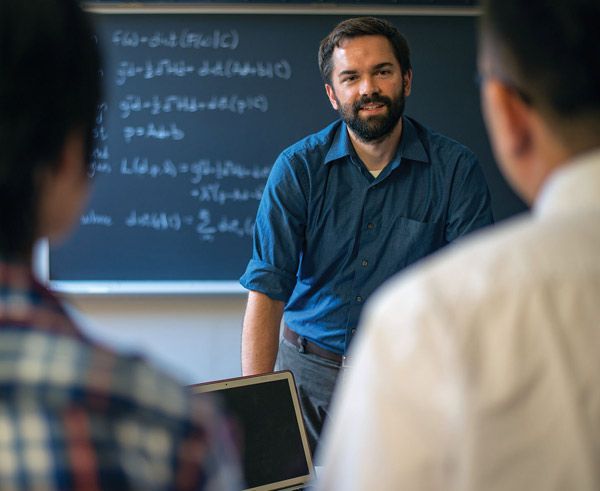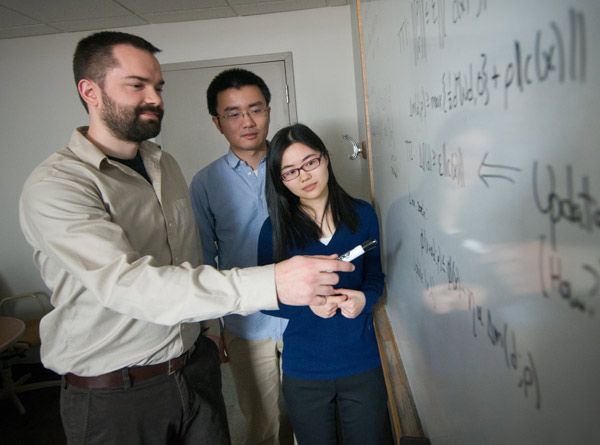“The test of a first-rate intelligence,” the American novelist F. Scott Fitzgerald wrote, “is the ability to hold two opposing ideas in mind at the same time and still retain the ability to function.”
Psychologists call this juggling of contradictory beliefs cognitive dissonance, and they say it is likely to induce stress.
Their warning, however, has not gotten through to Frank E. Curtis, who makes his living by finding simple solutions to problems of great complexity.
In a world characterized by uncertainty and randomness, Curtis has learned not just to function but to thrive.
Curtis, the Frank Hook Assistant Professor of Industrial and Systems Engineering, writes algorithms that enable computers to solve large-scale continuous optimization problems. He is collaborating with researchers at Argonne National Laboratory through a five-year Early Career Award from the U.S. Department of Energy (DOE).
In a three-year single-investigator project for the National Science Foundation, Curtis has developed algorithms that solve large-scale continuous optimization problems in less than a quarter of the time required by conventional methods.
The problems that interest Curtis contain countless variables and must be solved in real time. For the DOE, he and his students are seeking to achieve steady, efficient generation and distribution of electrical power while avoiding down time and allowing consumers to optimize the prices they pay. Each point of interest in a power network—from the power plants that generate electricity to the homes, schools and businesses that consume it—is represented as a node.
“At every node,” says Curtis, “there needs to be a balance; the input and output of electricity must be equal to each other. While the objectives differ between the consumption and generation nodes in a network, the principles everywhere are the same.
“Within a network, pricing must be set optimally and in real time for each consumption node. You have to manage supply and demand so that customers can optimize their use of energy—turning on appliances, perhaps, at those times of day when power is cheapest. You also have to enable network administrators to provide a steady flow of energy without the fluctuations that cause instabilities.”
Another continuous problem features an oncologist attempting to limit damage to healthy cells while destroying a tumor. The goal is to apply excessive heat to tumor cells while keeping the temperature below a lower threshold for noncancerous cells.
Curtis writes a partial differential equation that represents the temperature of every cell in and around the tumor while dealing with myriad variables: How will heat from radio or microwaves disperse across millions of cells? How will the temperatures of individual cells affect each other, and how will they in turn be affected by the amplitude and frequency of the radio or microwaves?
“Because the body is a continuous entity with many overlapping regions,” he says, “we have to model for space and time. We do that by turning one large-scale problem into a series of finite-dimensional ones.
“The goal is to come up with faster algorithms that achieve realistic solutions to problems that are complicated in terms of nonlinearity and in terms of making decisions under uncertainty, when we don’t have all the information we want.”
Tradeoffs are inevitable, says Curtis. A mathematical model’s representation of reality gains accuracy in proportion to the numbers of variables and equations it involves. But the more complicated a model becomes, the more time a computer requires to generate a solution.
To enable computers to solve the challenges posed by continuous complex systems, Curtis says, algorithms must be fast, dynamic and scalable—yet simple.
“We try to find the right balance between modeling the real world while achieving a practical solution. In our mathematical models, everything is an approximation of reality. We want to represent the real world while making problems tangible to solve.
“With power flow, for example, we model direct current instead of alternating current (AC)—not because this is how power behaves but because our equation becomes linear and can be more easily solved.”
His work, says Curtis, requires him to keep one foot in the real world of engineering and the other in the abstract world of applied mathematics.
“As a theoretician, you want to set up a mathematical model that’s as close to reality as possible, but you have to appreciate that your model needs to be solvable in order to be useful.
“On the other hand, real-world practitioners should have an appreciation for theory because that gives them a solid foundation for their ideas, which is critical if they want to solve more complex problems.”


